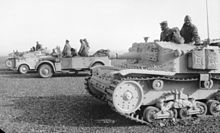Semovente 75/18
| Semovente since 75/18 | |
|---|---|

Semovente da 75/18 M42 |
|
| General properties | |
| crew | 3 men |
| length | 4.92 m |
| width | 2.20 m |
| height | 1.85 m |
| Dimensions | 14.4 t |
| Armor and armament | |
| Armor | up to 50 mm |
| Main armament | 1 × 75mm L / 18 Modello 34 |
| Secondary armament | 1 × 8 mm MG Breda 38 with 1104 rounds |
| agility | |
| drive | Diesel 145 HP (108 kW) |
| Top speed | 32 km / h |
| Power / weight | 10.06 hp / t (7.5 kW / t) |
| Range | 230 km |
The Semovente da 75/18 was an Italian assault gun that was used in World War II . The name is the Italian equivalent of the term self-propelled gun . The vehicle consisted of a superstructure with a relatively modern gun that had been placed on the hull of outdated types of tanks.
Planning and construction
At the suggestion of the Italian Colonel Sergio Berlese to develop a counterpart to the German StuG III , the M13 / 40 main battle tank was used to build the first prototypes of such a weapon by February 1941 . The concept of the StuG with an armored fixed structure was adopted, as a weapon the mountain gun 75 mm L / 18 Modello 34 was modified and built into the structure with a lateral directional range of 40 °. As a drive, the first vehicles still used the 125 HP (91.93 kW) weaker diesel engine of the M13 / 40 tank, later models based on the M14 / 41 received a 145 HP (108 kW) diesel. Models based on the M15 / 42 were powered by a gasoline engine with 192 hp. The riveted structure was armored on the front in two layers up to 50 mm thick.
The 75 mm main armament produced only a low muzzle velocity with 18 caliber lengths and could therefore only be used to a limited extent against moving targets. The projectile flew up to 9,500 meters at the maximum tube elevation. 44 grenades could be carried - however, some teams are said to have forced up to 100 projectiles into the interior. In addition to high - explosive shells , a shaped charge projectile called Effeto Pronto could be fired against tanks with a penetration rate of 70 mm.
Further development
Further developments of the 75/18 resulted in two similar models based on the M15 / 42 tank. The Semovente 75/34 was armed with a longer 75 mm cannon and the Semovente 105/25 with a 105 mm cannon.
commitment

The Semovente da 75/18 was delivered to the Italian army from 1941 . The vehicle was used both as an assault gun in direct fire and as divisional artillery with indirect fire . Two batteries of four 75/18 vehicles each were assigned to the artillery division of an Italian armored division.
The 75/18 assault gun was mainly used in North Africa from January 1942 . There these assault guns were the only Italian military vehicles that, despite their disadvantages (weak engine, cramped interior), had something to oppose the Allied tanks with their 75 mm cannon. Because they could penetrate 70 mm armor at 500 meters, they were able to penetrate both the Allied standard tanks M3 Lee / Grant and the M4 Sherman . Their slim silhouette and their thick armor compared to the medium tanks also proved to be a great advantage. However, since they were never produced in large numbers, they could not compensate for the inadequacies of the Italian armored weapon, which mainly relied on the M13 / 40 tanks. During the second battle of El Alamein , the Italian troops only had 30 Semovente 75/18.
After Italy's surrender in September 1943, the German Wehrmacht put 131 seized 75/18 under the name M42 (i) assault gun into service with their assault artillery troops . Since the tank factory was within the German sphere of influence, production there continued under German management.
A total of 467 Semoventi 75/18 were built (60 M40, 162 M41 and 190 + 55 M42), 55 of them after the Italian surrender in September 1943.
Preserved copies
- Semovente M41 da 75/18 in the Museo Storico della Motorizzazione Militare , Rome, Cecchignola
- Semovente M41 da 75/18 in the Museo Oto Melara, La Spezia
- Semovente M42 da 75/18 in the Museo dell'Aviazione, Rimini
- Semovente M42 from 75/18 in the Musée des Blindés , Saumur
See also
literature
- Ray Merriam: Italian Fighting Vehicles: World War 2 album. Merriam, 2015, ISBN 978-1576383896 .
Web links
Individual evidence
- ^ Ray Merriam: Italian Fighting Vehicles: World War 2 Album. Merriam, 2015, ISBN 978-1576383896 , p. 81.
- ↑ a b c d Ray Merriam: Italian Fighting Vehicles: World War 2 Album. Merriam, 2015, ISBN 978-1576383896 , p. 82.
